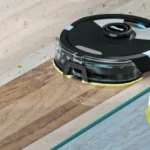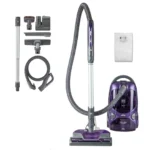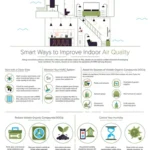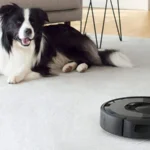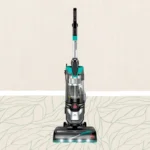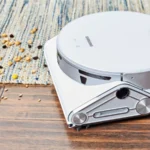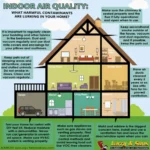Every day, we are exposed to a wide range of pollutants and allergens in our homes – from dust mites and pet hair to air-borne chemicals and mold spores. These indoor air pollutants can lead to a range of health problems, including allergies, asthma, and respiratory illnesses. Fortunately, smart vacuums with customizable suction settings offer a practical solution to improving indoor air quality. In this article, we will discuss the sources and effects of indoor air pollution, how smart vacuums work to improve air quality, tips for optimizing your vacuum, and other ways to improve the air you breathe. So let’s dive in and discover how we can all breathe a little easier!
Understanding Indoor Air Pollution
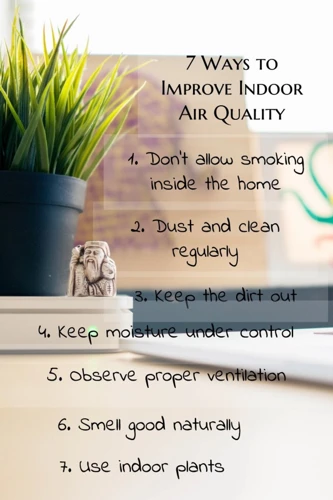
Did you know that indoor air can be up to five times more polluted than outdoor air? This may come as a surprise, but it’s true. The air we breathe inside our homes can be contaminated with a variety of pollutants, such as dust, pet dander, and even chemicals from household products. In this section, we will look into the sources and effects of indoor air pollution on your health. To learn more about how you can use smart vacuums with customizable suction settings to improve your indoor air quality, check out our guide on customized suction settings for smart vacuums.
Sources of Indoor Air Pollution
Indoor air pollution can stem from a variety of sources, some of which are discussed below.
| Source of Indoor Air Pollution | Effects on Health |
|---|---|
| Cigarette smoke | Increased risk of lung cancer, asthma, and other respiratory diseases. |
| Household cleaning products | Short-term effects can include respiratory irritation, dizziness, and headaches. Long-term exposure can increase the risk of certain cancers. |
| Dust and pet dander | Can trigger allergies and asthma. |
| Mold and mildew | Can cause respiratory irritation, trigger allergies, and exacerbate asthma symptoms. |
| Volatile organic compounds (VOCs) | Found in many household products such as paint, adhesives, and cleaning products. Can cause respiratory irritation, headaches, dizziness, and other symptoms. |
| Radon | A naturally occurring gas that can seep into homes through cracks in the foundation. Can increase the risk of lung cancer. |
It’s important to note that these sources of indoor air pollution are not the only ones. However, by using a smart vacuum with customizable suction settings, you can effectively capture and remove many of these pollutants from your home, leading to improved indoor air quality. To learn more about how to use customizable suction settings on different types of flooring, read our article on customizing suction settings for different flooring types. For a list of some of the top smart vacuums with customizable suction, see our guide on top smart vacuums with suction settings.
Effects of Indoor Air Pollution on Health
Indoor air pollution is a major health concern that is often overlooked. We spend a significant amount of time indoors, and poor air quality can impact our health in many ways. Here are some common effects of indoor air pollution on our health:
- Respiratory problems: Poor air quality may cause respiratory issues such as asthma, bronchitis, and coughing. These conditions may be especially severe in children and the elderly.
- Allergies: Allergens like pollen, dust mites, and pet dander can trigger allergies and cause symptoms such as sneezing, a runny nose, and itchy eyes.
- Headaches: Exposure to indoor air pollution may cause headaches and fatigue. These symptoms may be exacerbated in people with pre-existing medical conditions.
- Cancer: Some pollutants such as radon and volatile organic compounds (VOCs) have been linked to cancer.
To mitigate the harmful effects of indoor air pollution, it’s crucial to take steps to improve the quality of the air we breathe. One way to do this is by using smart vacuums with customizable suction settings.
How Smart Vacuums Help Improve Indoor Air Quality
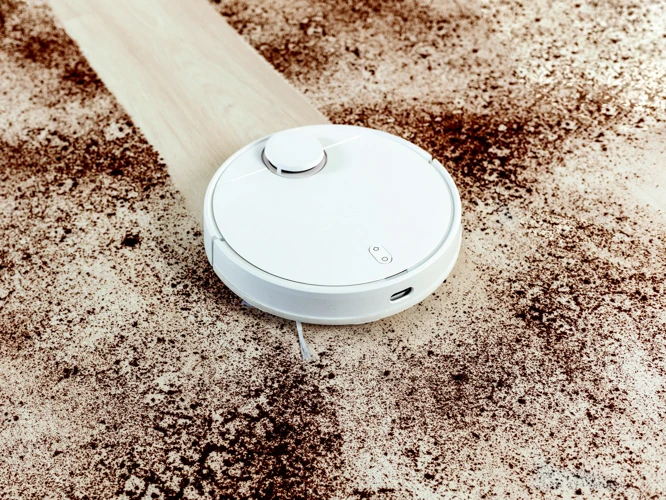
When it comes to improving indoor air quality, many people focus solely on air purifiers and ventilation systems. However, there’s one often overlooked tool that can make a significant difference: smart vacuums with customizable suction settings. These innovative devices offer a range of benefits that can help remove more pollutants and allergens from your home, making it a healthier and more comfortable place to live. In this section, we’ll explore how smart vacuums work and the ways in which they can help improve indoor air quality. So, get ready to learn how to optimize your cleaning routine with the latest technology! Don’t forget to check out our article about smart vacuums with customizable suction settings for more information.
Customizable Suction Settings to Remove More Pollutants
Smart vacuums on the market today come with customizable suction settings, allowing you to remove more pollutants and improve your indoor air quality. With these settings, you have the ability to adjust the suction levels according to the type of flooring, furniture, and other surfaces you want to clean.
Here are some tips for using customizable suction settings for optimal air quality improvement:
- For carpets and upholstered furniture, use a high suction setting. These surfaces trap more dirt, dust, and allergens than hard floors or solid furniture.
- For hard floors, use a low suction setting to avoid scratching or damaging the surface. A lower suction setting will still effectively remove dirt and dust without pulling up any loose tiles, damaging the floor finish, or leaving scrape marks.
- For curtains, cushions or anything more delicate, reduce the suction to the minimum for a gentle clean. You can always increase it slightly if necessary, but start with a low suction setting to avoid any damage.
- For areas or items with pet hair, use a higher suction setting that will pick up hair and dander more effectively, reducing allergens and improving air quality.
- Check the user manual for your smart vacuum to see if there are specific settings recommended for hard floors.
- If there are no specific settings, start with the lowest suction setting and work your way up until you find the right level for your flooring type.
- When using the vacuum, move the head slowly and steadily over the floor surface to allow the low suction to effectively remove debris without scattering it around.
- Bamboo charcoal bags: These bags are an eco-friendly and budget-friendly way to purify the air. They work by absorbing excess moisture and odors, which can improve indoor air quality.
- Beeswax and soy candles: Standard candles can release harmful pollutants into the air, but beeswax and soy candles are a natural alternative. They release negative ions which help eliminate pollutants from the air.
- Houseplants: Certain types of plants, such as spider plants and peace lilies, are known for their ability to purify the air by absorbing pollutants through their leaves and roots. Adding a few plants to your home can have a significant impact on air quality.
- Himalayan salt lamps: These lamps release negative ions which help eliminate pollutants from the air. They can also help improve mood and reduce stress.
Customizable suction settings allow smart vacuums to remove more pollutants since they target specific surfaces, allowing for more thorough cleaning. By using the optimal suction level, you can improve the air quality of your home and protect your health.
Efficient Filtration Systems
Smart vacuums with efficient filtration systems are essential for improving indoor air quality. These systems play a crucial role in trapping and capturing harmful pollutants, such as dust, allergens, and pet dander.
An efficient filtration system consists of multiple layers that work in tandem to remove particles of different sizes from the air. The two most commonly used filtration systems in smart vacuums are HEPA and ULPA filters.
HEPA filters are High-Efficiency Particulate Air filters that can remove up to 99.97% of particles as small as 0.3 microns. These filters are effective in trapping dust, pet dander, pollen, and other allergens. HEPA filters are perfect for individuals with allergies or asthma.
ULPA filters, on the other hand, are Ultra-Low Particulate Air filters that have a higher efficiency rate than HEPA filters. ULPA filters can capture particles as small as 0.1 microns and are effective in trapping smaller particles such as bacteria and viruses.
Some smart vacuums also come with additional filtration systems such as carbon filters that can absorb odors and VOCs (Volatile Organic Chemicals). These filters are useful for households with pets, smokers, or individuals with chemical sensitivities.
It is essential to note that the efficiency of the filtration system depends on how well it is maintained. It is recommended to change the filters periodically to ensure optimal performance. Refer to the manufacturer’s instructions on how often to change the filters and how to clean them.
Efficient filtration systems in smart vacuums play a crucial role in improving indoor air quality. HEPA filters are effective in capturing dust, allergens, and pet dander, while ULPA filters can capture smaller particles such as bacteria and viruses. Additional filtration systems such as carbon filters can absorb odors and VOCs. Regular maintenance and filter replacements are necessary for optimal performance.
| Filtration System | Particle Size | Efficiency Rate | Additional Features |
|---|---|---|---|
| HEPA Filters | 0.3 microns | Up to 99.97% | N/A |
| ULPA Filters | 0.1 microns | Higher than HEPA filters | N/A |
| Carbon Filters | N/A | N/A | Effective in absorbing odors and VOCs |
Tips for Optimizing Your Smart Vacuum
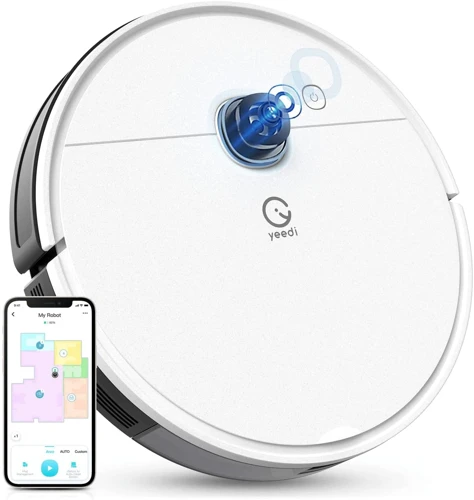
Are you looking to get the most out of your smart vacuum? Here are some helpful tips to help you optimize your device and improve indoor air quality in your home. With customizable suction settings and efficient filtration systems, these vacuums can make a big difference in the air you and your family breathe. Keep reading to learn how to use your smart vacuum to its full potential.
Using High Suction on Carpets and Rugs
When it comes to cleaning carpets and rugs, using high suction settings on your smart vacuum can really make a difference in improving indoor air quality. Carpets and rugs tend to accumulate a lot of dust, pet dander, and other pollutants, making them one of the main sources of indoor air pollution. However, using high suction settings can help remove these pollutants effectively.
But why use high suction on carpets and rugs?
Well, carpets and rugs have a thicker pile than hard floors, making it harder for a vacuum to penetrate and pick up the debris deep inside. Using high suction settings can increase the airflow and suction power, lifting more dirt and dust from the carpet fibers.
Tips for using high suction settings on carpets and rugs:
| 1. | Start by vacuuming the area thoroughly with the regular suction setting. |
| 2. | Switch to high suction setting and vacuum the same area again, this time slowly and in different directions. |
| 3. | Focus on high-traffic areas, such as entryways and hallways, where dirt and dust tend to accumulate the most. |
| 4. | Use the crevice tool to vacuum along the edges of walls and under furniture, where dirt and dust can hide. |
Remember, using high suction settings on carpets and rugs is important, but it’s also essential to choose the right setting for your specific flooring type. For hard floors, using high suction settings can scratch and damage the surface, which is why it’s recommended to use low suction settings instead.
By following these tips and using the customizable suction settings on your smart vacuum, you can effectively remove more pollutants from your carpets and rugs, ultimately improving the air quality in your home.
Using Low Suction on Hard Floors
When it comes to cleaning hard floors, using a vacuum with high suction power may not always be necessary. In fact, using high suction on hard floors can actually cause damage to the flooring. This is where using low suction on hard floors comes in handy.
The Benefits of Using Low Suction on Hard Floors
There are a few benefits to using low suction on hard floors, including:
| Benefits of Using Low Suction on Hard Floors |
|---|
| Prevents damage to floors |
| More gentle on delicate flooring materials |
| Removes debris without scattering it around |
How to Use Low Suction on Hard Floors
Using low suction on hard floors is easy. Most smart vacuums come with customizable suction settings, so you can adjust the suction power depending on the floor type. Here’s how to do it:
Conclusion
Using low suction on hard floors is a great way to protect your flooring from damage while effectively removing debris and improving indoor air quality. Remember to always refer to the user manual for specific recommendations, and start with the lowest suction setting before gradually increasing until you find the optimal setting for your hard flooring.
Other Ways to Improve Indoor Air Quality
When it comes to improving the indoor air quality of your home, using a smart vacuum with customizable suction settings and efficient filtration systems is just one piece of the puzzle. There are several other methods you can use to optimize the air you breathe. By implementing additional strategies, you can create a cleaner and healthier living environment for yourself and your family. Let’s explore some of these alternative tactics that you can use alongside your smart vacuum.
Regular Cleaning and Maintenance
Maintaining your smart vacuum is an essential aspect of improving your indoor air quality. Regular cleaning and maintenance ensure that your vacuum is functioning optimally, and its suction power remains consistent. Here are some tips for maintaining your smart vacuum:
| Maintenance Tasks | Frequency |
|---|---|
| Empty the Dustbin | After every use |
| Clean the Filter | Every 2-3 months |
| Clean the Brushes | Every 1-2 weeks |
| Check the Wheels | Every 1-2 weeks |
Emptying the dustbin after every use will prevent dust and other pollutants from accumulating inside your vacuum, allowing it to function at its maximum potential. Cleaning the filter every 2-3 months is crucial because it traps all the microscopic particles that the vacuum picks up. Over time, the filter will become clogged, affecting the suction power of your vacuum. Remember to clean the brushes and check the wheels to remove any hair or debris that may have accumulated.
In addition to these maintenance tasks, ensure that your smart vacuum is kept safe and protected. Always store it in a dry place and away from direct sunlight. You can also invest in a protective cover to protect your vacuum against dust and other pollutants.
By following these maintenance tips, you can ensure that your smart vacuum is always in tip-top condition, removing more pollutants from your indoor air and improving your overall air quality.
Using Natural Air Purifiers
Natural air purifiers can be a great addition to your home in addition to using smart vacuums with customizable suction settings. These purifiers can help eliminate pollutants and improve indoor air quality in a natural and non-toxic way.
Here are some natural air purifiers to consider adding to your home:
Combining the use of smart vacuums with customizable suction settings and natural air purifiers can create a clean and healthy indoor environment. By avoiding harsh chemicals and instead utilizing natural alternatives, you can breathe easy and feel confident in the air quality of your home.
Conclusion
After understanding the sources and effects of indoor air pollution, it’s clear that taking steps to improve indoor air quality is crucial for maintaining our health and well-being. Smart vacuums that feature customizable suction settings and efficient filtration systems are an excellent solution to combat harmful pollutants in our homes.
By using a smart vacuum with customizable suction settings, you have the power to remove more pollutants and allergens from carpets, rugs, and hard floors. High suction can effectively remove embedded dirt and debris from carpets and rugs, while low suction is gentle enough to use on hard floors without causing damage.
Regular cleaning and maintenance of your smart vacuum is also essential to ensure optimal performance and longevity. A well-maintained vacuum will continue to remove pollutants and allergens efficiently, making a significant difference in your home’s overall air quality.
Additionally, using natural air purifiers, such as plants or essential oils, can further improve indoor air quality. These alternatives are not only effective but also environmentally friendly, making them a sustainable option for consistent use.
Overall, using a smart vacuum with customizable suction settings and efficient filtration systems is an excellent step towards better indoor air quality. By taking action to reduce pollutants, we can safeguard the health of ourselves and our loved ones. Utilizing these tips and incorporating additional natural alternatives can make a significant impact on the air quality of your home.
Frequently Asked Questions
1. Can indoor air pollution cause health problems?
Yes, exposure to indoor air pollution can result in short-term and long-term health problems such as respiratory infections, asthma, and even cancer.
2. How can I tell if the air in my home is polluted?
You can tell if the air in your home is polluted by detecting odors, observing visible dust particles, or experiencing symptoms such as coughing and sneezing.
3. What are the sources of indoor air pollution?
Sources of indoor air pollution include cigarette smoke, pet dander, mold, pollen, household chemicals, and poor ventilation.
4. How does a smart vacuum help improve indoor air quality?
A smart vacuum can help improve indoor air quality by using customizable suction settings and efficient filtration systems to remove more pollutants from the air.
5. What are the benefits of using a smart vacuum with customizable suction settings?
Customizable suction settings allow you to adjust the power of your smart vacuum to suit different cleaning needs and remove more pollutants from your home.
6. Are smart vacuums efficient at removing pet hair and dander?
Yes, many smart vacuums come with attachments that are specifically designed to remove pet hair and dander from carpets and upholstery.
7. How often should I clean my smart vacuum?
You should clean your smart vacuum at least once a month to maintain its efficiency and prolong its lifespan.
8. Can natural air purifiers help improve indoor air quality?
Yes, natural air purifiers such as activated charcoal, beeswax candles, and salt lamps can help remove pollutants from the air and improve indoor air quality.
9. Why is using high suction on carpets and rugs important?
High suction on carpets and rugs helps remove embedded dirt and pollutants that can trigger asthma and allergies.
10. What can I do to prevent indoor air pollution?
You can prevent indoor air pollution by improving ventilation, using natural cleaning products, and avoiding smoking inside your home.

